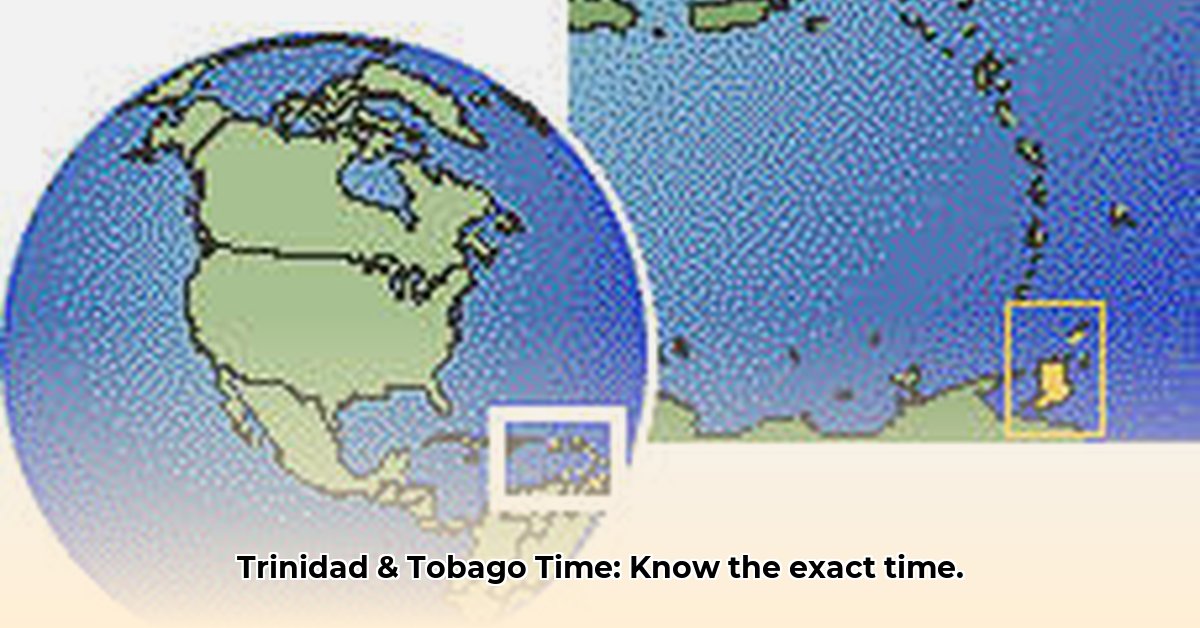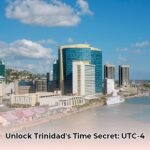Knowing the correct time in Trinidad and Tobago is essential for business, travel, and daily living. This comprehensive guide provides reliable methods for determining the current time, explores the intricacies of timekeeping in the region, and offers practical tips to ensure your devices are perfectly synchronized. Whether you’re a local resident or an international visitor, this article equips you with the knowledge to stay on schedule. For further information on time changes, check out this helpful resource on adjusting clocks.
Understanding Time in Trinidad & Tobago
Finding the accurate time in Trinidad and Tobago is straightforward. The country operates on Atlantic Standard Time (AST), which is UTC-4. Trinidad and Tobago does not observe daylight saving time, maintaining a consistent time zone year-round. This simplifies scheduling and coordination for residents and businesses. This fixed time system provides predictability and stability, establishing continuity since 1945.
Decoding the Timekeeping System
While AST simplifies daily life, the underlying technology that powers time synchronization is complex. Devices rely on signals from time servers linked to highly accurate sources, typically atomic clocks. These atomic clocks are located around the world in national metrology labs for precise timekeeping. These signals ensure clocks stay synchronized. Knowing more about these underlying systems enhances understanding.
Transparency regarding these processes may be limited due to security and infrastructure management considerations. However, the consistent time displayed by online resources is generally sufficient for everyday use.
Evaluating Online Time Service Accuracy
A simple online search reveals numerous websites displaying the current time in Trinidad and Tobago. While most accurately report AST, minor discrepancies of a few seconds may occur. These differences arise from data transmission lags, website synchronization methods, and other technical factors. Do these discrepancies significantly affect specific industries?
For most applications, these slight variations are negligible. These microscopic differences are unlikely to cause issues for casual events. However, industries requiring precise time synchronization, such as finance and scientific research, demand more specialized time sources. These sectors benefit from high-precision timekeeping.
Identifying a Trustworthy Time Source
To find a reliable online time source for Trinidad and Tobago, prioritize websites known for accuracy and transparency. While minor variations may exist, reputable providers offer consistent time displays.
Here’s a summary of commonly used sites:
| Website | Time Zone Reported | Daylight Saving Time? | Reliability (Subjective) | Notes |
|---|---|---|---|---|
| timeanddate.com/worldclock/trinidad-and-tobago | AST (UTC-4) | No | High | Widely used and generally accurate. |
| time.is/Trinidad_and_Tobago | AST (UTC-4) | No | High | Simple and straightforward. |
| 24timezones.com/Trinidad-and-Tobago/time | AST (UTC-4) | No | High | Offers additional time zone information. |
| dateandtime.info/country.php?code=TT | AST (UTC-4) | No | High | Another reliable option. |
(Note: While researching, ensure the links function properly, as broken links can occur.)
Envisioning the Future of Timekeeping
Future improvements in time service provider transparency would be beneficial. Detailed explanations of data acquisition methods would increase user confidence. Enhanced collaboration among organizations could also improve reliability. A standardized national time synchronization system could significantly improve national time accuracy, enhancing international business capabilities.
Recommendations for Accurate Time
For everyday use, the listed websites provide sufficient accuracy. Most modern devices synchronize automatically. However, businesses requiring precise timing, such as financial institutions and telecommunications companies, should consider specialized, professional time synchronization services. These services provide superior accuracy and reliability. Consider the level of precision required; readily available online services are adequate for most general needs.
Ensuring Accurate Time Synchronization for Businesses in Trinidad and Tobago
Trinidad and Tobago relies on precise timekeeping for many functions, including financial transactions and infrastructure upkeep. Ensuring your clocks display the correct time is essential for business operations. Let’s explore how to ensure accurate time synchronization in Trinidad and Tobago. Are businesses prepared for the importance of precise timekeeping?
Why Accuracy Matters
Accurate time is the backbone of numerous systems. Financial institutions require precise timestamps for transactions. Government agencies require it for official records. Computer systems depend on synchronized time. Therefore, how to ensure accurate time synchronization in Trinidad and Tobago is vital.
Time Synchronization Methods
Several methods keep clocks synchronized. The Network Time Protocol (NTP) is the most common. Devices connect to time servers for regular updates. This is simple and generally reliable. The Precision Time Protocol (PTP) offers even greater accuracy for maximum precision but requires complex setups and specialized knowledge. High-frequency trading needs this level of precision.
Practical Synchronization Steps
Follow these steps for getting started:
- Select a Reliable Time Source: Choose a trustworthy time server. Consider server distance for minimal latency and its reputation for accuracy.
- Configure Devices: Configure devices to synchronize with the time server via NTP. Adjust operating systems using built-in features.
- Monitor Regularly: Check system clock accuracy regularly. Small discrepancies accumulate over time. Visual checks and automated monitoring tools are available.
- Establish Backup Systems: Set up a backup time source for critical systems. This prevents interruptions during primary server failures, ensuring continuous operational efficiency.
- Seek Professional Assistance: For complex systems and cybersecurity concerns, consult an IT consultant specializing in network time synchronization.
Addressing Synchronization Issues
Despite efforts, synchronization issues can arise. Network issues, server outages, and hardware problems disrupt synchronization. Check the network connection first. Restart devices and verify time settings. If problems persist, contact a specialist.
Key Takeaways:
- Accurate timekeeping is vital for applications in Trinidad and Tobago.
- NTP is a straightforward method for time synchronization.
- Regular monitoring ensures continued accuracy.
- PTP and redundancy are recommended for high-precision needs and critical systems, yielding benefits to industries from finance to telecommunications.
- Professional IT support addresses complex challenges and security concerns.
Reliable Trinidad & Tobago Time Sources for Business
Key Takeaways:
- Trinidad and Tobago’s consistent Atlantic Standard Time (AST), UTC-4, simplifies internal scheduling.
- Businesses must account for time differences with international partners, especially during daylight saving time in other regions.
- Several reliable Trinidad & Tobago time sources for businesses are available online, fostering operational efficiency.
Understanding Trinidad and Tobago Time Zones
The nation observes Atlantic Standard Time, ensuring consistency for internal business operations. This continuous schedule simplifies business for everyone.
- Discover Fermentation Revolution: The Health Benefits of Kimchi: Sustainable Farming Practices - July 30, 2025
- Discover Living Crystals: The Giant Gypsum Formations in Naica’s Cave: A Geological Marvel - July 30, 2025
- Master Molecular Gastronomy: The Science That Turns Your Kitchen into a Lab: Beginner-Friendly Recipes - July 30, 2025
















